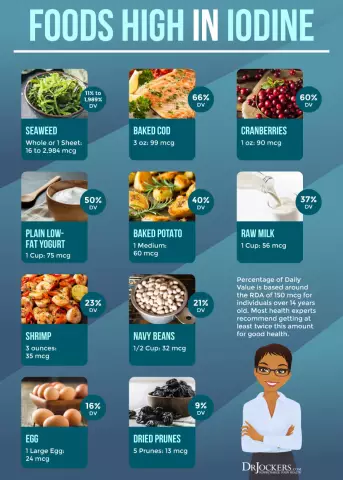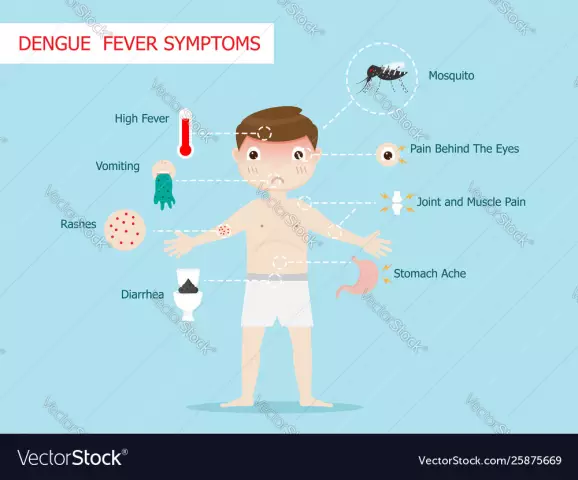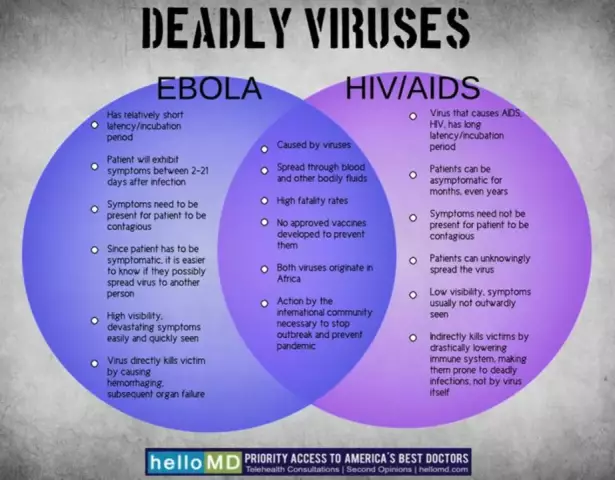- Author Rachel Wainwright [email protected].
- Public 2023-12-15 07:39.
- Last modified 2025-11-02 20:14.
Smallpox
General characteristics of the disease
Smallpox is a contagious viral infection that can only affect humans.
This disease is characterized by general intoxication and a kind of rash on the mucous membranes and skin, after which numerous scars almost always remain. This infection is caused by two types of viruses: the causative agent of smallpox (the mortality rate of the infected is 20-40%, and according to some reports - about 90%) and the causative agent of Alastrim (the mortality rate is about 1-3%).
The natural smallpox virus is highly resistant: it can persist for several days on linen and in the dust of rooms, for more than a year it remains active in the patient's crusts after exfoliation, in the dark, and in the light for about 2.5 months.
The smallpox virus dies after half an hour when heated to 60 0 C, after 1-5 minutes - up to 70-100 0 C and after 6 hours from exposure to ultraviolet radiation. In half an hour, alcohol, hydrochloric acid, acetone and ether can neutralize the smallpox virus.
Epidemiology
A sick person is a source of infection from the last days of incubation of the virus until the moment the crusts fall off.
The greatest danger is represented by patients in whom the symptoms of smallpox are erased, which makes it difficult to recognize the disease, as a result of which the isolation of patients is often delayed.
However, the danger is not only the patient, but also the things with which he came in contact. The infection can be transmitted both by airborne droplets and by airborne dust, by household contact. Mechanical transfer of smallpox by flies is also possible. The susceptibility to infection in people who do not have immunity to it is almost one hundred percent. Children are most susceptible to smallpox infection. A person who has had this infection acquires strong immunity for a long time, but not for life. Smallpox vaccination provides immunity to the disease for 3-5 years, after which revaccination is required.
The smallpox virus was spread on all continents, but today this disease has been defeated with the help of mass vaccination in the countries of the world community. In 1980, the eradication of smallpox was officially announced. To date, the variola virus is in two laboratories owned by the United States and Russia; the WHO postponed the question of its final destruction until 2014.
Smallpox symptoms
The incubation period in a typical course of the disease lasts about 8-12 days.
The initial period is characterized by such symptoms of smallpox as: chills, fever, intense thirst, tearing severe pain in the sacrum, lower back and extremities, headache, dizziness, vomiting. In some cases, there may be a mild onset of the disease, with erased manifestations of infection.
On days 2-4, an initial skin rash or a hemorrhagic rash, localized on both sides of the chest up to the armpits, on the inner surfaces of the thighs and in the folds below the navel, joins the above symptoms of smallpox. A spotted rash usually lasts for several hours, while a hemorrhagic rash lasts a little longer.
On the 4th day, the clinical symptoms of smallpox begin to weaken, the temperature decreases, but pockmarks appear on the skin - a typical manifestation of this disease. Poxins begin their existence in the form of spots, then they turn into papules, which, in turn, become bubbles, which subsequently turn into pustules (suppuration). The last stages that pockmarks go through are the formation of crusts, their rejection and the formation of a scar. In addition to the skin, smallpox eruptions, which then turn into erosion, also appear on the mucous membrane of the nose, larynx, oropharynx, bronchi, female genital organs, on the rectum, conjunctiva and other organs.
For 8-9 days of the disease, the stage of suppuration of the vesicles is characteristic, which is accompanied by a deterioration in the well-being of patients, the appearance of signs of toxic encephalopathy (agitation, delirium, impaired consciousness).
Smallpox in children at this stage may be characterized by seizures. It takes 1-2 weeks for the pockmarks to dry out and fall off, after which numerous scars remain on the scalp and face. In a particularly severe course of the disease, the infected can die before the stage of the appearance of the rash.
Smallpox vaccination allows, in case of infection, to transfer the disease easily and without complications. In vaccinated patients, moderate malaise is observed, not very pronounced signs of intoxication, an abundant smallpox rash, pustules are not formed, as a result of which scars on the skin do not remain. Lighter forms of smallpox are also possible, characterized by short-term fever, the absence of severe disorders and rash. A feature in vaccinated patients is also the duration of the incubation period, which is 15-17 days. Recovery usually occurs in two weeks.
Complications of smallpox can be sepsis, iritis, keratitis, panophthalmitis, pneumonia, meningoencephalitis, encephalitis.
Smallpox treatment

Smallpox symptoms are the basis for specific studies, as a result of which the final diagnosis will be made.
Smallpox in children and adults in most cases has a typical clinical picture, therefore, the treatment of these age groups is similar.
Due to the fact that effective means of treating smallpox for a long time were absent, magic and "folk" methods of getting rid of the infection were widely used. Today, for the treatment of smallpox, if necessary, antiviral drugs and anti-smallpox immunoglobulin can be used, which is injected intramuscularly in a dose of 3-6 ml. In order to prevent the addition of a bacterial infection, it is advisable to apply antiseptic drugs to the affected areas. In the case of bacterial complications, antibiotics such as cephalosporins, macrolides, and semi-synthetic penicillins are suitable for treating smallpox. With this disease, measures are needed to help detoxify the body.
Dr. Hubert V. O. in the late 19th century, he used smallpox vaccination to treat the disease. Infected people were given a daily vaccine against this infection, which significantly alleviated the symptoms of smallpox. Today, it is impossible to say with confidence why this method of treatment has not become widespread.
Smallpox prevention
Disease prevention measures include early diagnosis of infection, isolation of patients, quarantine, disinfection, and prevention of import from other countries. As medical practice and world history show, smallpox vaccination is the most important and effective way to prevent the disease.
YouTube video related to the article:
The information is generalized and provided for informational purposes only. At the first sign of illness, see your doctor. Self-medication is hazardous to health!






